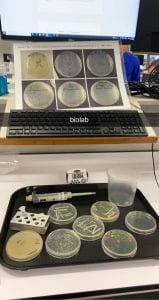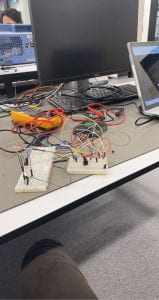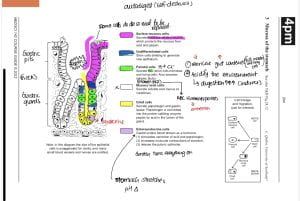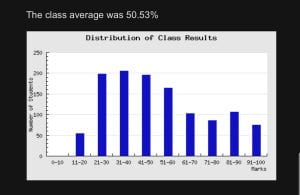Welcome back to the blog! Hope everyone is doing well during the exam period. As we marked the end of semester 2 a few weeks back, I can now tell you what you can actually expect from it. For starters, I would say it is slightly worse than semester 1 (which is shocking as I thought nothing can top ENGSCI 233), but this is a subjective opinion and perhaps for others, semester 2 was better.
BIOMENG 261
This is perhaps one of the easier papers you will find in BME. It is split into three modules: reaction kinetics, bioengineering labs and ethics.
At first glance, the reaction kinetics module seems complicated as it covers a wide scope of mathematics and biology. Personally, it felt like the content was not a second year course because of the depth the lecturer talks about mathematical modelling and reaction kinetics. However, the maths is “dumbed” down with a plethora of assumptions which leaves less mathing for us. Additionally, the tests for this module are repetitive, so practising one or two papers guarantees you those A+’s you dream of. I still remember the median for our reaction kinetics test being 38/40.

The Bioengineering lab module is the more interesting side of BIOMENG 261. You get to work with equipment such as spectrophotometers and grow bacteria on agar plates. You have 5 labs, each worth 5% of your grade. Here you learn how to refine your laboratory skills, which you hopefully would have practised in BIOSCI 107. This means you actually do need to get your own lab coat, and not rely on your Biomed friends like me. My favourite topic from this module would be the genetic modification lecture, as you learn about gene editing techniques like CRISPR cas 9 and the basics of how this is done with recombinant DNA. It complements well with the immunology/ cells & processes module in BIOSCI 107. I had to cross reference these lectures to get a better understanding of the scope of this course, so I highly recommend having these notes handy.
The ethics module is also intriguing. Its purpose is to build your awareness around ethical practices that have been conducted in the past and how it has evolved to the present. While you need to only take away halfa page’s worth of information, the 6 lectures on this module are relaxing lectures where you essentially debate with the class about contentious topics. If you are worried about how this is assessed in the exam, rest assured that the same questions get asked every year. The median for this assignment was also 56/60, which speaks for itself.
BIOMENG 241
This course follows on from ELECTENG 101. You are split into about 8 groups and are tasked to design a mini engineering project. This was a handheld colorimeter for us, and I think it has been like that for many years.
The project required a substantial amount of teamwork and independence. You cannot expect to be guided on every aspect of the project, but as a group you are required to carry out the processes yourself. This includes the case design, circuitry and measurement software of the device.
Every week you are introduced to a different aspect required of the project in the laboratories. The first week you learn about the design process, which is self-explanatory and nothing new from 115. In the following weeks, you learn about the softwares required for the circuit design of the project, such as ALTIUM and LTspice. These are required for your printed circuit board (PCB). You then have to solder these components and focus on how to operate it using LABVIEW – the measurement software. I found LABVIEW the hardest part of this course, so I recommend spending extra time on the laboratory exercises for this.

The weekly assignments for this course are a bit irksome, as these are kinda the only practice questions you get for the content you learn in class. This means you can’t really tell if you are doing the right thing, but the good news is that it isn’t weighted that much – I believe only 2% per assignment.
The bulk of this course lies in your project. Up till the 6th lecture on electronic design, you should have already gotten an idea for your case design and have a model on CAD for this. After the Electronic Design lecture, that is when you will have a good idea on the LED and photodiode circuitry for the project. Make sure to test this on the breadboard and seek help with the helpful TAs in the weekly laboratory sessions. The best part of this course is how the lectures finish a few weeks before the exams, leaving ample time to study for exams and finish the project.
ENGGEN 204
This is a general communications course you take with every other part II engineer. As Biomedical Engineering students with a cohort of around 30 students, it is nice to see new faces during these lectures (that is, if you ever show up to them). The attendance for these lectures plummets exponentially. The overflow room was used in the first few weeks, then hardly ¼ of students turned up (including myself). Simply put, the purpose of this course is to engender awareness around working in a team which involves effective communication.
You are divided into a group of around 8 students from different specialisations and are tasked to work on three different projects – a video, report and presentation project. These are not difficult to tackle as long as you dedicate about two meetings a week. Just make sure you don’t procrastinate and assign roles as soon as possible. Other bloggers have covered these aspects in-depth, so I will refrain from repeating it. Please do check out their blogs if you are interested in what these projects involve.
The tests for this course are strange. By strange, I mean that you have to accept you have no common sense and zero intuition. You have to CTRL-F the slides for every single question. While the content in this course was interesting and helpful, the idea that we are being tested on how well we read the slides, as opposed to our understanding of it did not sit right with me. This was felt by many students in light of the angry piazza posts you will see when the grades are released. These tests are online and are weighted 20% each. This means there is no exam for this course, so you can gauge what territory your grade might be in before the exams start.
MEDSCI 142

This course is a first year premed course. Please don’t be deceived by the fact it is a first year course, because I spent more time on this than any other course. Although, I’ll admit it is one of my favourite courses as you get to learn more detail about different body systems, which you would have only briefly touched upon in BIOSCI 107. It is a content heavy course, but you get lots of guidance with the concept check activities and piazza. The best part of the course would be the fortnightly labs where you do different dissections/experiments. The most iconic lab would be the rat lab, where you get to see the different organs (mainly part of the digestive system) in the rat, which only relates to the last module. They have a short quiz worth 2% at the end of the lab that is mostly based on recall type questions.
The different body systems you learn include nervous, endocrine, renal, digestive, cardio, musculoskeletal and respiratory. My favourite system is perhaps digestive because it ties in well with what we learn in rat lab and the concepts have a logical flow to it. You’ll find this for a lot of the topics. Musculoskeletal is a little content heavy and memorisation of every minute detail is unfortunately required, especially for the exam. Topics like cardio and respiratory are also heavy, however, they are clearly covered in the lab and reinforce one another, so I wouldn’t worry about these modules until after the lab.

My tips for this course would be to engage in active learning techniques rather than passive ones, which is what Angela (the course director for this course) encourages in her little study module. I found going through each learning objective to be helpful as well, since every question in your test corresponds to one of the learning outcomes. Bear in mind the mean for the medsci 142 tests were 50%, which emphasises the importance of consistent/active study. In retrospect, I wish I had made better notes on one platform (such as notion or onenote) about each lecture, as they test you on what they say during the lectures. For instance, we had a whole question on how to test for COVID-19 in our respiratory anatomy lecture, which was not in our course notes but was something our lecturer had mentioned in class, although I thought it was only for interest purposes.
If I could do this course again, I would definitely attempt practice exams and MCQs earlier than I did. Doing practice exams right after the module would be better, so you can address your learning gaps earlier, rather than keeping it to the last minute. Even if you haven’t finished studying for the modules, I believe it might be more efficient to attempt these resources so at the very least, it guides you in what to study.
Overall, these four courses provide much more depth into Biomedical Engineering as opposed to the semester 1 courses. Harder or easier than sem 1? Who knows? It depends on your strengths and weaknesses. I am confident you will do well if you choose BME, and hope to you see in my next post :))
